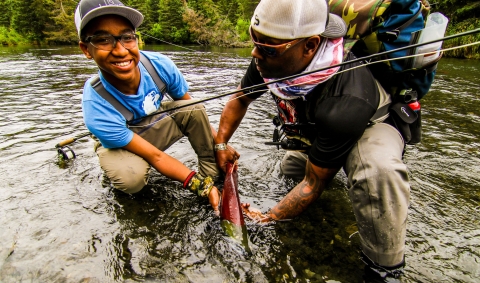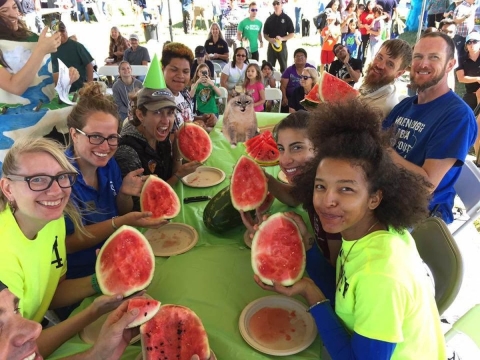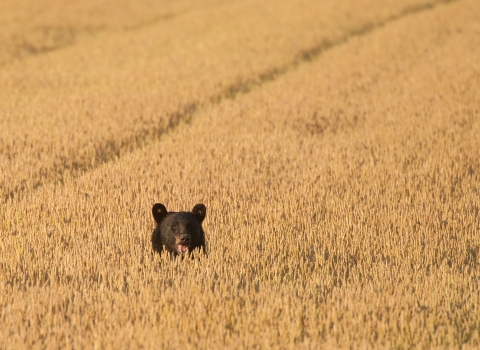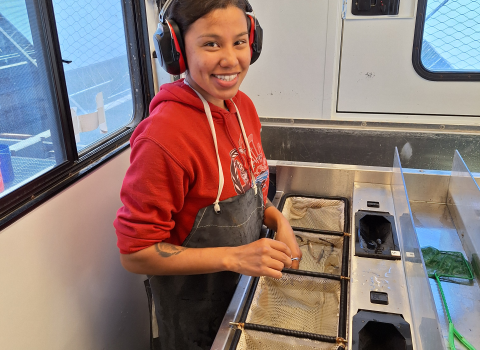Add some nature to your life. You’ll be healthier for it. A large and growing body of research supports the idea that getting outdoors — on national wildlife refuges, for example — can improve your peace of mind and physical well-being.
Many refuges are working with their communities to strengthen that health-and-nature connection. They’re expanding trails, teaching outdoor skills, sending nature broadcasts to sick children and taking other creative steps.
Refuge managers say the efforts meet visitors’ needs and interests.
“Health is a big concern for Mountain View residents,” says Jennifer Owen-White, who, as refuge manager at Valle de Oro National Wildlife Refuge, is working with community members and partners to improve environmental health and access to green space for the industrial area near Albuquerque, New Mexico.
The refuge, she says, has extended a bike trail from the refuge to the community, helped turn abandoned lots into pollinator gardens, planned a nature-themed kids’ space in a neighborhood clinic and hosted regular outdoor events to draw area residents to the refuge. “Just being out in nature helps a lot with mental health,” says Owen-White. (Video: “Not Your Typical Refuge”)
Salt marshes are found in tidal areas near the coast, where freshwater mixes with saltwater.
Learn more about salt marsh habitat and wildlife on a bike tour at Don Edwards San Francisco Bay National Wildlife Refuge.
In California, Don Edwards San Francisco Bay National Wildlife Refuge is once again hosting quarterly bike tours — after the Covid pandemic put these on hold. The tours, led by the San Francisco Bay Wildlife Society (the refuge Friends group), highlight a healthful outdoor recreational activity available at the refuge.
At designated stops along the tour, participants learn about salt marsh and other habitats as well as topics such as bird migration, salt pond restoration and local history.
In the Alaskan village of Akiak, on Yukon Delta National Wildlife Refuge, Yupik leader and substance-and-behavior-abuse counselor Mike Williams Sr. thanks area refuges for helping to encourage Alaska Natives to live healthy, substance-free lives.
For years, Williams spread that message by competing in the Iditarod — the annual dog sled race from Anchorage to Nome. In the lower 48 states, the race is viewed as an extreme endurance event. In Alaska, it’s more closely identified with cultural heritage and healthy outdoor living. “I’ve been mushing for sobriety and wellness since 1992,” says Williams. Lately, he’s retired from racing and helps his son compete instead.
The Iditarod race trail runs adjacent to Koyukuk, Nowitna and Innoko National Wildlife Refuges, and one year crossed Koyukuk Refuge. Refuge staff often help at race checkpoints in McGrath and Galena. They also promote the value of traditional, healthy outdoor lifestyles and teach villagers gun safety, trapping skills, wilderness safety and observation skills, and the use of local edible and medicinal plants.
At some refuges, health connections are growing. For the past several years, chapters of Zeta Phi Beta Sorority, Inc., a national partner of the U.S. Fish and Wildlife Service, have taken sorority members and their families to local refuges each spring to encourage healthy outdoor recreation.
A 2020 trip planned to Marais des Cygnes National Wildlife Refuge in Pleasanton, Kansas, would have been the third in four years for Zeta’s Kansas City, Kansas, chapter, had the Covid pandemic not gotten in the way. The chapter "visited" the refuge virtually instead that year.
Trip organizer Helen Beteet recalls impressions from their first visit in 2017.
“We selected the location because it was only 45 minutes away and most people hadn’t visited it,” she says. “It was nice to see how you could travel not very far and see how Kansas was before cars and roads.
“We took the kids on a nature walk. What was interesting was to move, in less than a couple of miles, from a typical Kansas plain to a forest terrain. The kids learned about the migration of monarch butterflies and had the opportunity to plant milkweed, the plant that helps nourish the monarch. It was enjoyable for kids and adults.”
The Houston Community Partnerships and Engagement program provides virtual field trips to young people, including some who are bedridden in hospitals and health facilities. “Virtually Wild! Texas” uses a digital platform that “takes” young viewers to coastal wetlands, forests, prairies, zoos and other locations. From their personal electronic devices, viewers can interact directly with conservation professionals from wildlife refuges, state forests and nonprofit groups.
“If anybody needs nature, it’s these kids,” says Nancy Brown, public outreach specialist with Texas Gulf Coast Refuges. “It’s an opportunity to pull them out of their hospital setting and away from their illness.”
One video broadcast shows a flying squirrel being treated at the Wildlife Center of Texas, a wildlife rehab facility. “Who can relate better to a small injured animal than a child who's in a hospital?” Brown asks. “It’s a message of hope: This flying squirrel is getting better. You can get better, too.”
Partnerships are key to many refuge health-and-nature initiatives. In Oregon, Tualatin River National Wildlife Refuge partners with Soul River Inc., a nonprofit founded by Navy veteran Chad Brown. Brown says fly-fishing helped him deal with PTSD; now, he and the refuge bring inner-city youth and military veterans together on local rivers to heal and learn from one another.
At Florida's St. Marks National Wildlife Refuge, former supervisory park ranger Robin Will represented the Service on a state coalition that, with a grant from health insurer Florida Blue, trained more than 150 Leon County physicians to write “nature prescriptions” for their patients. “The refuge is a resource for physicians to give their patients to get outdoors,” said Will, who retired in 2021.
Sometimes refuge visitors make the health connection on their own.
After California’s deadly Paradise Camp fire displaced them and nearly 35,000 others from their homes in November 2018, Julie Graulich and her husband found solace and healing in weekly visits to Sacramento National Wildlife Refuge.
“For a few hours we didn’t have to make any decisions, or wonder where we would live, or think about losing a home that we loved,” says Graulich. “Watching for and photographing wildlife took us out of our heads and connected us to something bigger than ourselves. …We always left there feeling better than when we came."
More than a year later, Graulich and her husband were still keeping up their weekly refuge visits, calling it their ‘therapy session." Said Graulich, "It's no joke. It’s the one thing we do that consistently gives us joy, renews our spirit and reminds us to be grateful for the beauty that’s all around us.” Wildlife photos that Graulich took at Sacramento Refuge accompany her essay about her experience in the Los Angeles Times.
Are refuges’ efforts to link health and nature worthwhile? Absolutely, say those involved.
“We think it fits right in line with what we should be doing as an urban refuge,” says Valle de Oro Refuge manager Jennifer Owen-White.
“One of the standards of excellence for an urban refuge is ‘Be a community asset.’ We knew that the health of the Mountain View neighborhood was really important to the community. So we knew to be an asset, we should help with this goal.”
“It’s easier to convey the importance of outdoor spaces when people see connections to their everyday lives.”
Other Service staff see themselves in the connections business, too.
At Kanuti National Wildlife Refuge in Alaska, Service staff work with village communities to coordinate the refuge’s annual Henshaw Creek Culture and Science Camp, where tribal Elders share traditional ecological knowledge with youth.
At the week-long camp, Elders teach young camp-goers how to harvest fish with a set net, build a fish-drying rack, smoke fish and collect edible berries.
Encouraging youth to follow traditional ways and harvest natural food sources such as salmon, moose and berries promotes health. That’s because these foods are high in nutrients and are free of chemical additives found in processed foods — a dietary alternative for many Alaskans living in remote locations.
At Koyukuk National Wildlife Refuge in Alaska, ranger Karin Bodony teaches Alaska Natives to use plants for food and medicinal purposes, re-connecting them to parts of their cultural heritage with which some have lost touch and helping them live more independently. “It’s part of our establishing purpose,” she says. “It’s understood that people are part of ecosystem here.”
“I think that connection [between health and nature] is what makes our jobs vital.”
Photo album, health and nature














